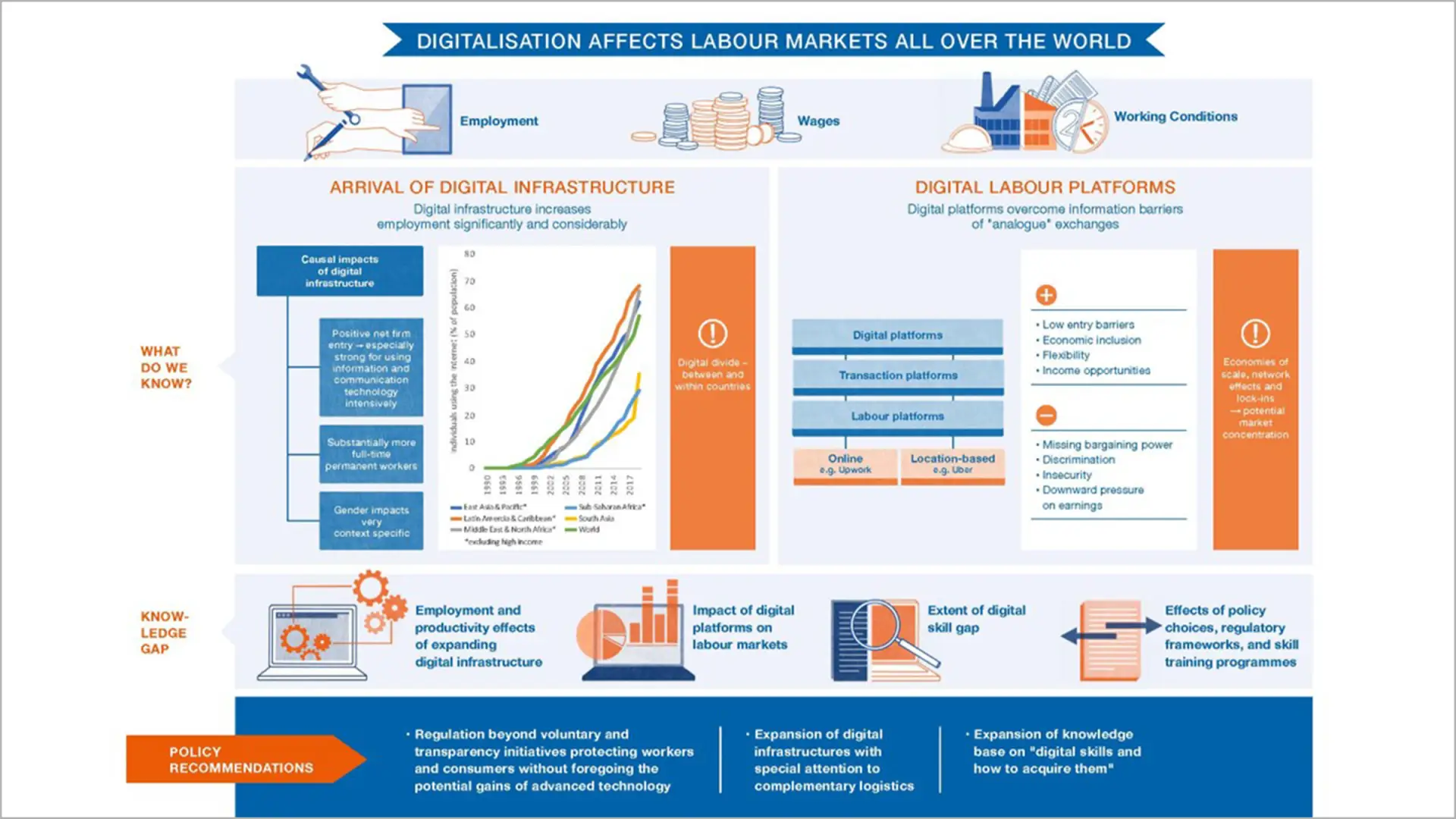- Startseite
- Publikationen
- GIGA Focus
- Digital Skills in the Global South: Gaps, Needs, and Progress
GIGA Focus Global
Digital Skills in the Global South: Gaps, Needs, and Progress
Nummer 2 | 2023 | ISSN: 1862-3581

The arrival of AI-powered chatbots has made many people think once again about the skills needed for the "digital future of work." Any efforts to improve digital skills are addressing a moving target, which implies that teaching the appropriate skills is not a trivial matter. What is certain, though, is that there is a very considerable digital skills gap between richer and poorer countries.
The demand for digital skills is very heterogeneous, ranging from basic digital literacy that enables individuals to effectively use simple digital tools to the advanced digital skills necessary to participate in the “global division of digital labour.”
The limited data available suggest that levels of digital literacy are relatively low in countries of the Global South. Low-income countries exhibit extremely low levels of digital literacy, while the gaps between middle-income and high-income countries are also very considerable.
The evidence on the use of digital technologies in schools suggests that most middle-income countries lag far behind high-income countries, particularly in schools with students with low socio-economic status. This may cause digital skills gaps to persist or even grow.
Digital skills training programmes are proliferating, without having proven their effectiveness in terms of enhancing digital skills.
Some evidence indicates that job referrals or training in the use of professional online platforms may be as important as digital training in improving employment prospects.
Policy Implications
Our assessment of digital skills in the Global South calls for policy action to address the yawning digital skills gap between high-income countries and low- and middle-income countries. This is a precondition for equitably harnessing the potential gains of digitalisation. Such policies will need to rest on a considerably expanded knowledge base regarding "digital skills," how to acquire them, and their labour market relevance.
Digital Skills Are in High Demand
Digital skills are key to being prepared for the future of work. A basic level of "digital literacy" is required to make effective use of digital services such as financial services or online tools for farmers, or to work via location-based labour platforms such as app-based ride-hailing or delivery services. Only advanced digital skill levels enable workers to participate successfully in digital industries or online labour platforms, which are used to offer and supply online and remote tasks. The demand for digital skills is thus heterogeneous. It differs across sectors and occupations, as well as across countries with different initial technological conditions and skill endowments (Strietska-Ilina and Chun 2021). Foundational digital skills that enable individuals to access and engage with digital technologies are of primary importance in most (poorer) countries (World Bank and International Finance Cooperation (IFC) 2021). These are entry-level skills required for the basic and effective use of digital devices and applications. In contrast, in countries with important and growing tech industries, demand for the higher-order skills required to use technology for task-oriented purposes and specific information and communication technology (ICT) occupations and professions is increasing.
Empirical studies on the demand for digital skills indeed show these patterns. In a case study of digital skills demand for several African countries (Rwanda, Nigeria, Mozambique, Kenya, and Côte d’Ivoire), the World Bank and IFC (2021) point to a largely unmet demand for digital skills that differs between countries. The authors estimate that by 2030 at least foundational digital skills will be required for 50 to 55 per cent of all jobs in Kenya; 35 to 45 per cent of all jobs in Côte d’Ivoire, Nigeria, and Rwanda; and 20 to 25 per cent of jobs in Mozambique. The demand for digital skills will originate from occupations outside ICT specialties and will result from adopting – not developing – digital technologies. Most of the demand (70 per cent) will therefore be for foundational skills, followed by 23 per cent for non-ICT intermediate skills.
Another study by the Asian Development Bank and LinkedIn (Asian Development Bank and LinkedIn 2022) looks at digital skills and demand in selected Asian countries. The study relies on (a) the analysis of 38,000 standardised skills self-reported by LinkedIn members from India, Indonesia, Malaysia, and the Philippines benchmarked against data from Australia, Singapore, and the United States, and (b) a survey among employers (and digital training providers) in Bangladesh, India, Indonesia, and the Philippines, plus the United States. The latter survey indicates that individuals with intermediate skills (“deploying hardware and software to build tools, platforms, and applications that can be easily used by others with only basic digital skills”) or advanced digital skills (“develop new technologies such as artificial intelligence (AI), robotics, and genetic engineering”) are in high demand. Further, the LinkedIn data reveals that explicitly “digital job profiles are more common in developing countries, while business and management professionals are (more) sought after in the more advanced economies. For example, in Indonesia and the Philippines, the fastest-growing job profiles include managing online content and social media. Accordingly, the ability to use Microsoft Office, Adobe Photoshop, and Adobe Illustrator are specific skills that are in high demand. Specific software knowledge, for example, Java and SQL, are in demand in every country studied.
Such studies clearly indicate a growing demand for digital skills. They also conclude that this demand is not being met. Specifically, the report by the ABD and LinkedIn (Asian Development Bank and LinkedIn 2022) notes that 48 per cent of employers state that even though candidates meet the degree requirements, they might not have the necessary skills for the job. In the following, we start with an assessment of the digital skills gap by examining the scarce comparable data (at least when it comes to low-income countries) on digital skills. The available data suggest that there is a yawning digital skills gap between poorer and richer countries that will require very considerable effort to address. This effort has to start early on in schools, where digital skills will have to be taught much more effectively. We discuss this very important issue only superficially here and focus instead on digital reskilling and upskilling through training.
Where Do We Stand? Huge Digital Skills Gaps
Measuring “digital skills” is not a trivial undertaking. Based on an extensive literature review, Strietska-Ilina and Chun (2021) highlight that digital skills comprise foundational (basic digital literacy), meta-cognitive (transversal ICT skills, e.g. the use of software), and technical/hard skills (intermediate/advanced digital skills, e.g. programming). Socio-emotional skills influence how effectively these skills can be applied and may gain importance as some technical tasks are increasingly performed by machines. Digital skills are thus a set of skills that matter in a “digitalised labour market.” It should not go without mentioning that this skill set is constantly changing. The recent rise of very potent AI chatbots, for example, probably means that some hard technical skills, such as programming, will be less relevant than some might have assumed not so long ago.
With these complexities in mind, the subsequent review of selected indicators still reveals some important patterns in terms of digital skills worldwide and in the developing world. In general, the availability of comparable data on digital skills is clearly biased toward higher-income countries. We present data from two different sources: first, from the UN reporting in the context of the Sustainable Development Goals (SDGs) and, second, from a World Bank report based on data from the world’s most widely used professional networking app, LinkedIn.
Target 4.4 of the SDGs reads, “By 2030, substantially increase the number of youth and adults who have relevant skills, including technical and vocational skills, for employment, decent jobs, and entrepreneurship.” This target is operationalised through, among other things, indicator 4.4.1, the “proportion of youth and adults with information and communications technology (ICT) skills,” and indicator 4.4.2, the “percentage of youth/adults who have achieved at least a minimum level of proficiency in digital literacy skills” (United Nations Statistical Commission 2021).
Indicator 4.4.1 is disaggregated by age, sex, and nine subskills, including the “proportion of youth and adults who have copied or moved a file or folder” and the “proportion of youth and adults who have used basic arithmetic formulas in a spreadsheet.” As of 2020, 94 countries had ever reported data on any subskill under indicator 4.4.1. For example, 90 countries (including high-income countries) provided information on the proportion of individuals who had copied or moved a file or folder. With 93 countries reporting, slightly more information is available on the proportion of individuals who have used a specialised programming language.
Thus, data on digital skills are scarce for developing countries. There are very few low-income countries among those reporting any data on indicator 4.4.1 (see Figure 1 and Figure 2). The limited data available illustrate the huge discrepancies in digital skills across countries. In Chad or the Central African Republic, for example, only a very small fraction of adults (1.6 and 2.4 per cent, respectively) have copied or moved a folder, and for several countries this share is not much higher than 40 per cent or below (Figure 1). The share of people who have used basic arithmetic formulas in a spreadsheet is also very low for most low- and middle-income countries. In poor African countries, including Chad, the Central African Republic, Niger, and Togo, fewer than 1.5 per cent of individuals are equipped with these skills. The majority of poor countries do not even reach 25 per cent (Figure 2) – compared to approximately 50 per cent in highly skilled Korea and only 35 per cent in Germany.
Figure 1. Proportion (%) of Youth and Adults Who Have Copied or Moved a File or Folder (Latest Year Available)
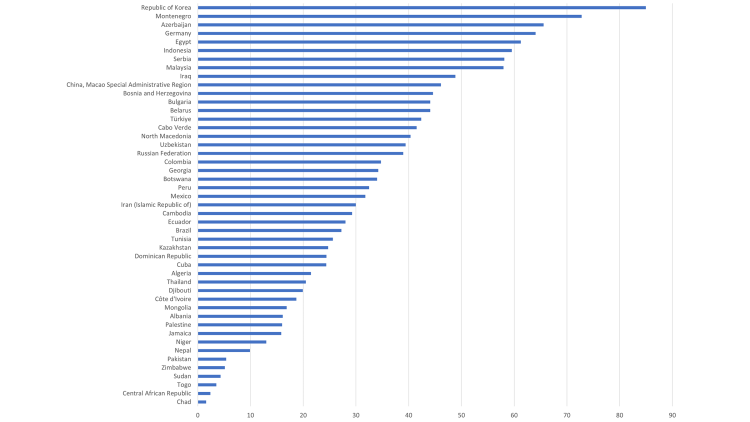
Source: UNESCO Institute for Statistics (2022).
Figure 2. Proportion (%) of Youth and Adults Who Have Used Basic Arithmetic Formulas in a Spreadsheet (Latest Year Available)
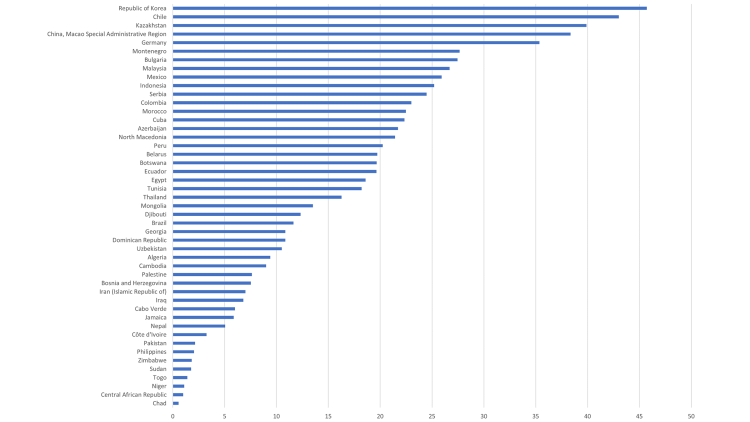
Source: UNESCO Institute for Statistics (2022).
UNESCO's indicator 4.4.2 measures digital literacy using a specific module of the Programme for the International Assessment of Adult Competencies (PIAAC), which is available for only 31 countries, including only six low- and middle-income countries and no African country. UNESCO defines digital literacy as "the confident and critical use of a full range of digital technologies for information, communication, and basic problem-solving in all aspects of life." Using the PIAAC data, UNESCO defines a digital literacy threshold beyond which individuals are, for example, likely to "figure out how to send an email message to a number of contacts using an unfamiliar bulk email function," or (ii) "use a sorting tool to make it easier to locate sales numbers for a specific product in a company spreadsheet" (or tasks of similar difficulty). Thus measured, digital literacy is very low in countries such as Ecuador (5 per cent digital literacy) and Peru (7 per cent). However, to put this into perspective, even in the high-income Republic of Korea, the share of individuals with a minimum level of digital skills is only 30 to 35 per cent (Figure 3).
Figure 3. Percentage of Youth/Adults Who Have Achieved at Least a Minimum Level of Proficiency in Digital Literacy Skills
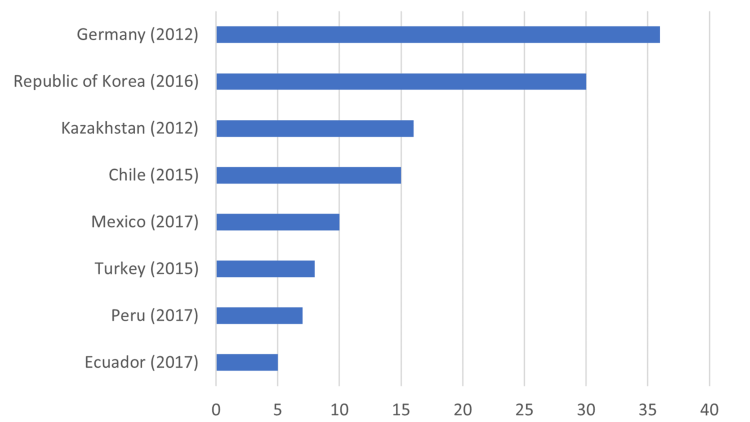
Source: UNESCO Institute for Statistics (2022).
These data suggest that levels of digital literacy and, specifically, foundational digital skills are relatively low in developing countries. Yet the above statistics are partial and, at times, outdated. Further, there is a non-negligible digital workforce in selected low- and middle-income countries (Bangladesh, India, Kenya, Nigeria, Ukraine etc.) that is active on online labour platforms and possesses some intermediate or advanced digital skills (ILO 2021). Assessing the prevalence of such more advanced digital skills and their quality is important because a digitally well-trained workforce is necessary for developing "home-grown" digital technologies and providing and improving digital infrastructures. One way to collect data on the "digital workforce" is through professional networking platforms. A World Bank report (Choi, Dutz, and Usman 2020) titled "The Future of Work in Africa" uses data on "business-related digital skills" from LinkedIn – that is, from individuals who must have some basic digital skills to register with the platform. These data have to be interpreted with caution (for a detailed discussion, see Choi et al. 2020) because (a) LinkedIn users may not be representative of the "digital workforce," (b) the composition of users may differ systematically between regions, and c) the data are all self-reported with the related problems of over- and underreporting as well as different interpretations of skills. Further, the figures are from 2019 – that is, relatively outdated by digital-age standards. Bearing these caveats in mind, the LinkedIn data suggest that sub-Saharan African workers have fewer digital skills than workers in other regions, even among the 4 per cent of the African labour force that uses LinkedIn (among 27 sub-Saharan African countries with LinkedIn data). In the report, digital skills are judged against the average global "skill penetration" – that is, the adoption of a series of specific skills. In North America, the 70 per cent of the labour force that uses the platform exhibits a digital skill penetration of about 1.5, whereas in sub-Saharan Africa, the 4 per cent of users exhibit a digital skill penetration of -0.5 (with 1 as the average global digital skill penetration). The availability of digital skills varies very significantly across the developing world. In South Africa, 17 per cent of the labour force are LinkedIn members with digital skills equivalent to the global average. Kenya and Nigeria also score much higher than the rest of Africa in terms of digital skills but fall well behind Brazil and India, where the reported skill penetration is close to that of the USA. This may suggest that at least some digital skills can be acquired through training and practice.
The Digital Gap in Schools
However, the foundations for digital skills are clearly laid at school. All over the world, educational systems are struggling to adapt to digital technologies and to develop and implement appropriate curricula. Any detailed discussion of the many challenges and issues involved goes beyond the scope of this short brief. Yet we want to stress the importance of early digital skills development and flag some issues that are particularly relevant for developing countries. One obvious issue is that access to digital technologies for children (in school and out of school) is as unequal – between and within countries – as access to these technologies for the population at large. For example, data from PISA 2018 – that is, mainly from OECD countries – show that 88 per cent of students had an Internet connection at home and a computer they could access for schoolwork, an increase of 28 percentage points compared to PISA 2003 (OECD 2021). In low- and middle-income countries, this share was substantially lower. In countries such as the Dominican Republic, Indonesia, Malaysia, Mexico, Morocco, Peru, the Philippines, Thailand, and Vietnam – that is, the more advanced economies of the Global South – only half or less of the students had access to the Internet and a computer at home. Further, as illustrated in Figure 4, there are huge inequalities in these access rates between children in "advantaged" schools (top 25 per cent according to PISA average score at the school level) and "disadvantaged" schools (bottom 25 per cent). In Peru, the country where this discrepancy is largest, almost 90 per cent of students in advantaged schools have access to the Internet and a computer at home, in contrast to less than 10 per cent in disadvantaged schools.
Figure 4. Access to a Computer Connected to the Internet at Home for Doing Schoolwork, according to Schools’ Socio-Economic Status (Percentage of Students in Advantaged and Disadvantaged Schools)
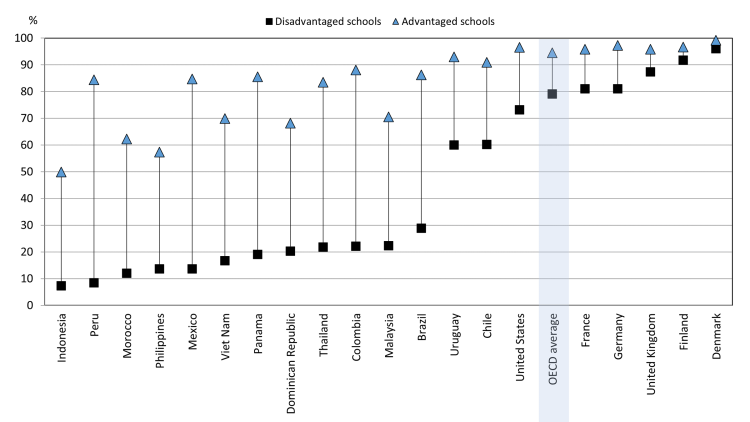
Source: Authors’ own elaboration based on OECD (2021) statistics.
Note: A socio-economically disadvantaged (advantaged) school is a school whose socio-economic profile (i.e. the average socio-economic status of the students in the school) is in the bottom (top) quarter of the PISA index of economic, social and cultural status amongst all schools in the relevant country/economy.
Overcoming the international gaps and national inequalities will require huge effort, and it will be difficult to compensate through later training efforts. Evidence on how foundational digital skills can best be taught in school is accumulating, including that from hardware distribution programmes, such as One Laptop per Child (OECD, Economic Commission for Latin America and the Caribbean, and CAF Development Bank of Latin America and European Commission 2020). Some key findings from the literature on the "digitalisation" of teaching are not overly surprising. Instead of teaching separate computer classes, the use of technologies should be applied in all subjects, and teachers need to be equipped with the right skills to be able to convey digital skills as well (World Bank 2016). Simply distributing laptops does not help (much). Evidence from the One Laptop per Child programme in several Latin American countries often shows little effect. In Uruguay, where the programme was implemented on a national scale, it did not affect school performance indicators in the first two years. However, in Peru, the programme improved computer literacy. These evaluations suggest that when the use of ICT is well integrated into curricula by well-trained teachers, it can have a positive impact on learning outcomes while at the same time ensuring that digital skills are taught. A meta-analysis of randomised experiments (McEwan 2015) shows that interventions were less effective when laptops were simply distributed, without guidance from a parent or teacher. Notwithstanding the efforts to effectively teach foundational digital skills at schools, improving adults' digital skills at various levels will have to be a central policy priority.
Digital Skills Training (for Adults)
There is a strong rationale for advancing the digital skills of the global workforce, particularly in developing countries. Digital skills training for adults is ubiquitous. Digital training needs are very heterogeneous, context-specific, and dependent on initial conditions. These needs range from foundational digital skills training, such as using simple digital tools to participate in locational labour platforms or improve individual, business, or farm productivity, to intermediate or advanced digital skills courses that prepare participants for jobs on online labour platforms and other jobs in ICT occupations.
Worldwide, millions of adults have participated or are participating in various such training offers. "Big tech" plays a key role in organising and implementing these training offers, many of which are offered for free, but there are also many smaller-scale programmes. The public sector, including national governments, international organisations, and development cooperation efforts, supports some of these private-sector programmes (ILO 2021) but also engages in various own initiatives. The scale of some of these programmes is impressive. For example, Microsoft's Global Skills Initiative, which provides free access to training on LinkedIn Learning, Microsoft Learn, and GitHub Learning, was taken up by 30.7 million people in 249 countries within only eight months after its launch (during the COVID-19 pandemic). After the United States, the countries with the most learners were India and Brazil, followed by the United Kingdom and Mexico. Amazon Web Services has announced that it intends to provide free cloud-computing training to 29 million people by 2025. In India, Google is collaborating with the Indian School of Business and the Ministry of Electronics and Information Technology on a digital skills initiative that aims to bring 41 million small and medium enterprises online. The programme consists of 5,000 in-classroom training sessions across India. The Indo-Pacific Economic Framework for Prosperity (IPEF) Upskilling Initiative (from the Asia Foundation and the US administration) plans to set up 7 million or more training and education opportunities on using digital tools for women and girls in, among other countries, India, Indonesia, Malaysia, the Philippines, Thailand, and Vietnam. Atinigi, a learning platform supported by the BMZ – which is not just for digital skills – has more than 400,000 registered users and has counted 170,000 completed courses. In 2020/21, Go Digital ASEAN trained more than 200,000 individuals across the region in digital skills, and the Digital Transformation Centres (DTC) Initiative from ITU and Cisco reportedly also reached more than 100,000 people in the Americas, the Asia-Pacific region, and Africa.
These impressive figures on training participants documented in various reports, websites, and press releases suggest that the programmes are successful – at least in terms of take-up. In light of the proliferation of these programmes, it is surprising that – according to our assessment of the empirical literature and very few project evaluation reports – evidence of their effectiveness in terms of transmitting digital skills, increasing productivity and/or improving labour market outcomes is very limited. We could only find two rigorous impact evaluations of digital skills training programmes – both implemented in Africa – which we present below. Before that, we briefly summarise the wealth of evidence available on training programmes in general, which, in our view, contains some useful lessons to be learned for training programmes with digital content.
The rich evidence on the efficacy of job training interventions – not explicitly targeted at increasing digital skills, among others, is mixed. Some interventions are successful at increasing earnings or the probability of employment, but many are not, for example, pure soft-skills training. There is a tendency towards integrated, multipronged interventions that combine vocational training with a capital infusion to be more effective. The same holds for high-quality and high-intensity interventions that involve private firms. The results cannot be easily generalised, as the impacts of these programmes are context- and beneficiary-specific. These findings are likely to be relevant in the context of digital skills training programmes as well. They also certainly hold for the importance of market demand for the acquired skills, which can be guaranteed by strong involvement of the private sector, which generally tends to raise training programme effectiveness, as market needs are better anticipated. Further, McKenzie (2017) points out that although studies indicate small positive effects of training programmes, their costs may render them inefficient. This may be less relevant for digital skills programmes that can rely, to an important extent, on online material with little cost for additional users.
The only rigorous impact evaluation of a “digital skills training programme” is the unpublished study by Atkin, Schoar, and Wahnscha (2021). The authors have evaluated the impact over multiple years of a relatively short (10 days, five hours a day) training programme titled Artificial Intelligence 101 by Sama in Nairobi, Kenya. It teaches basic digital skills, occupational skills relevant to the digital and business-outsourcing industries, and job-search preparation, and it targets low-income youth with little experience and no formal training. After programme completion, participants can apply to the Sama Delivery Centres for training on tasks including image tagging, image annotation, data classification, and dataset creation. The authors use a randomised controlled trial to evaluate programme impacts (control group, training only, training and job referral). The results show that individuals who have participated in training and job referral have 37 per cent higher earnings, are 10 percentage points less likely to be unemployed, and work 22 per cent more hours per week than the control group. These effects are particularly strong for women. Looking at the group that has received training only, the authors find that 16 months after training completion, individuals have worse employment outcomes than the control group, which indicates that they struggle to find work. These negative effects disappear 2.5 years after training completion, and employment rates and hours worked are slightly (but not significantly) higher than in the control group. After training completion, people who have received training only thus wait for jobs in the ICT sector and ultimately switch to other sectors.
These findings are instructive, but one must be careful not to overgeneralise from one study. It is surprising to see a relatively large and sustained impact from a relatively light-touch intervention, a 10-day training session. This contradicts the findings from other studies on skills training, which suggest that training needs to be intensive and long to be effective. Yet the fact that it only works with referrals casts doubts on the effectiveness of the training. Instead, it suggests that the second component of the programme, the job referrals, is what really matters. This, in turn, implies that, at least in the Kenyan context where the programme was implemented, labour market frictions that inhibit the efficient matching of job seekers with vacant jobs play an important role.
Here, another digital skill – namely, the effective use of online professional networking platforms – comes into play. Such platforms, including online job-search, networking, and hiring platforms, may reduce information frictions within labour markets and help efficiently match individuals with specific skills with suitable jobs. They can provide information about employers and the jobs they offer as well as job seekers and their profiles, they provide access to a network on both the demand and supply side of the market, and they thus very significantly lower the costs of matching. A significant part of the workforce is already engaged with such platforms. Evidence on the effects of participating in such platforms is scarce. Wheeler et al. (2022) is the first rigorous study on the labour market effects of participating in professional networking platforms. The study is of relevance here, since the participants are trained to open a LinkedIn account. The study is based in South Africa and relies on a sample of participants in the Harambee Youth Employment Accelerator programme. This six-to-eight week programme works with disadvantaged youth and covers workplace simulation, team building, and non-cognitive skill development. The intervention provides a randomly selected subsample of Harambee participants with additional training on how to open a LinkedIn account, construct a profile, join groups, make connections, and ask for recommendations. The LinkedIn training replaces approximately four hours of the normal course materials. This light-touch intervention has produced big results: participants who received the extra training on LinkedIn were approximately 10 per cent more likely to be employed by the end of the overall training course (and six months later) than the control group that did not receive the extra training.
These two impact evaluations forcefully illustrate that such evidence is needed to design digital skills interventions that work. However, their external validity – that is, whether the results can be generalised to other contexts – is certainly limited. The scarcity of evidence on the effectiveness of digital skills training offers may be partly due to the fact that the programmes are still relatively young. We can only speculate about other reasons, but the frequent involvement of the private sector probably makes the implementation of impact evaluations somewhat more difficult (this is at least our personal experience). To our knowledge, none of the large-scale digital skills training programmes mentioned in the introduction to this section have been rigorously evaluated. Overall, there is thus tremendous potential for systematic learning in this policy field, including through rigorous evaluations.
Conclusion
For good reasons, most governments around the world are prioritising digital skills as part of their digital agendas. Our review of the literature on digital skills and related policies highlights the heterogeneity of the demand for digital skills, from basic digital literacy that enables people to effectively use (simple) digital tools to advanced digital skills that facilitate participation in the "global division of digital labour." Identifying how to support digital skills development and what to prioritise is not a simple matter. It depends, of course, on the initial conditions, and we were surprised to see that empirical knowledge on these initial conditions in terms of digital skills is very limited – outside the OECD. The limited data available suggest that levels of digital literacy are relatively low in developing countries. Low-income countries exhibit extremely low levels of digital literacy, while the gaps between middle-income and high-income countries are also very considerable. The evidence from the OECD's PISA studies on the use of digital technologies in schools suggests that most middle-income countries lag far behind (particularly in disadvantaged schools), which may cause these gaps to persist or even grow. Digital skills training as an active labour market policy will not be able to compensate for failings in earlier-stage digital education. Digital training programmes are proliferating, and in our view they are doing so without having proven their effectiveness in enhancing digital skills and improving employment prospects. Interestingly, the few rigorous studies available indicate that improving employee-employer matching (through job referrals or teaching the effective use of online professional platforms) may be more important than (just) training itself for obtaining employment. All this calls for a considerable expansion of the knowledge base on "digital skills and how to acquire them" as a precondition for overcoming digital skills gaps and harnessing the potential gains of digitalisation.
Acknowledgments
The authors gratefully acknowledge funding from the "Context matters" project funded by the German Federal Ministry for Economic Cooperation and Development (BMZ). This study is part of the series of "Trend Analyses". The opinions expressed in this publication are those of the authors. They do not purport to reflect the opinions or views of the German Agency for International Cooperation (GIZ) or the BMZ.
Fußnoten
Literatur
Asian Development Bank, and LinkedIn (2022), Digital Jobs and Digital Skills: A Shifting Landscape in Asia and the Pacific, Manila, Philippines: Asian Development Bank.
Atkin, David, Antoinette Schoar, and Kiara Wahnscha (2021), Evaluating Sama’s Training and Job Programs in Nairobi, Kenya.
Choi, Jieun, Mark A. Dutz, and Zainab Usman (eds) (2020), The Future of Work in Africa, African Development Bank, World Bank Group.
Fietz, Katharina, and Jann Lay (2023), Digitalisation and Labour Markets in Developing Countries, GIGA Working Paper 335, June (forthcoming).
ILO (2021), World Employment and Social Outlook 2021: The Role of Digital Labour Platforms in Transforming the World of Work, S.l.: International Labour Office.
McEwan, Patrick J. (2015), Improving Learning in Primary Schools of Developing Countries: A Meta-Analysis of Randomized Experiments, in: Review of Educational Research, 85, 3, 353–394.
McKenzie, David (2017), How Effective Are Active Labor Market Policies in Developing Countries? A Critical Review of Recent Evidence, in: The World Bank Research Observer, World Bank Group, 32, 2, 127–154.
OECD (2021), 21st-Century Readers: Developing Literacy Skills in a Digital World, PISA, OECD.
OECD, Economic Commission for Latin America and the Caribbean, and CAF Development Bank of Latin America and European Commission (2020), Latin American Economic Outlook 2020: Digital Transformation for Building Back Better, Latin American Economic Outlook, OECD.
Strietska-Ilina, Olga, and Hae-Kyeung Chun (2021), Changing Demand for Skills in Digital Economies and Societies: Literature Review and Case Studies from Low- and Middle-Income Countries, Geneva: ILO.
UNESCO Institute for Statistics (2022), SDG4 Indicators, accessed 27 May 2023.
United Nations Statistical Commission (2021), Official List of SDG 4 Indicators, accessed 25 May 2023.
Wheeler, Laurel, Robert Garlick, Eric Johnson, Patrick Shaw, and Marissa Gargano (2022), LinkedIn (to) Job Opportunities: Experimental Evidence from Job Readiness Training, in: American Economic Journal: Applied Economics, 14, 2, 101–125.
World Bank (2016), World Development Report 2016: Digital Dividends, Washington, DC: World Bank.
World Bank, and IFC (2021), Demand for Digital Skills in Sub-Saharan Africa, Washington, DC: International Finance Corporation, accessed 27 May 2023.
Redaktion GIGA Focus Global
Lektorat GIGA Focus Global
Forschungsprojekt
Forschungsschwerpunkte
Wie man diesen Artikel zitiert
Fietz, Katharina, und Jann Lay (2023), Digital Skills in the Global South: Gaps, Needs, and Progress, GIGA Focus Global, 2, Hamburg: German Institute for Global and Area Studies (GIGA), https://doi.org/10.57671/gfgl-23022
Impressum
Der GIGA Focus ist eine Open-Access-Publikation. Sie kann kostenfrei im Internet gelesen und heruntergeladen werden unter www.giga-hamburg.de/de/publikationen/giga-focus und darf gemäß den Bedingungen der Creative-Commons-Lizenz Attribution-No Derivative Works 3.0 frei vervielfältigt, verbreitet und öffentlich zugänglich gemacht werden. Dies umfasst insbesondere: korrekte Angabe der Erstveröffentlichung als GIGA Focus, keine Bearbeitung oder Kürzung.
Das German Institute for Global and Area Studies (GIGA) – Leibniz-Institut für Globale und Regionale Studien in Hamburg gibt Focus-Reihen zu Afrika, Asien, Lateinamerika, Nahost und zu globalen Fragen heraus. Der GIGA Focus wird vom GIGA redaktionell gestaltet. Die vertretenen Auffassungen stellen die der Autorinnen und Autoren und nicht unbedingt die des Instituts dar. Die Verfassenden sind für den Inhalt ihrer Beiträge verantwortlich. Irrtümer und Auslassungen bleiben vorbehalten. Das GIGA und die Autorinnen und Autoren haften nicht für Richtigkeit und Vollständigkeit oder für Konsequenzen, die sich aus der Nutzung der bereitgestellten Informationen ergeben.













